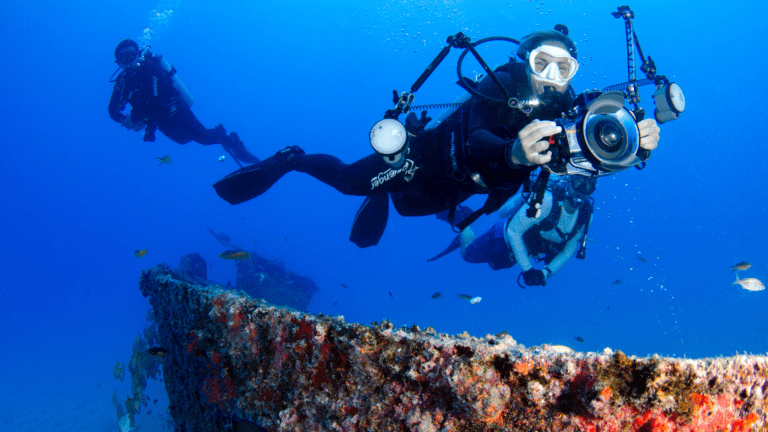Macro diving is a favorite among underwater photographers, offering an up-close look at the intricate details of the ocean’s tiniest inhabitants. However, the very aspects that make it so rewarding also present unique challenges, particularly for photographers. Here’s why macro diving stands out as a true test of underwater photography expertise.
Locating the Subjects
One of the first challenges in macro diving is finding your subjects. Marine creatures like nudibranchs, frogfish, and shrimp are often incredibly small and camouflaged, blending seamlessly into their surroundings. Spotting them requires patience, sharp observation, and sometimes the guidance of a knowledgeable dive buddy or guide.
Unlike larger marine life, macro subjects often inhabit nooks in coral, seagrass beds, or sand, requiring divers to move slowly and scan the environment meticulously. Beginners may find this overwhelming at first, as it demands a high level of focus and an ability to adapt to the dive site’s specific conditions.
Pro Tip: Use a pointer stick or a muck stick to help direct your focus without disturbing the environment. This can save time and increase your chances of finding hidden critters.
Perfecting Buoyancy
Photographing macro subjects demands precise buoyancy control. Even a slight movement can kick up sediment, disturb the subject, or ruin your shot by shifting your camera’s focus. For some, achieving this level of stillness can take extensive practice, especially in areas with strong currents or limited visibility.
The challenge is heightened when shooting in close quarters, such as crevices or beneath overhangs. Poor buoyancy not only affects your photography but also risks damaging delicate marine habitats.
Solution: Practice hovering techniques in calm waters or during simpler dives to refine your buoyancy control before attempting macro diving.

Mastering Lighting
Lighting is a key factor in underwater photography, but it becomes even trickier in macro diving. Natural light is often insufficient for capturing the vivid colors and intricate textures of small marine life. Flash or strobe lighting is essential, but it must be used carefully to avoid overexposure or harsh shadows.
Reflective surfaces, such as the shells of crabs or the bodies of certain fish, can create unwanted glare, while darker subjects can appear flat without proper illumination. Finding the balance requires both technical knowledge of your equipment and an understanding of how light interacts underwater.
Equipment Tip: Invest in a strobe or LED light with adjustable power settings. Diffusers can help soften the light and avoid harsh shadows.
Composition Challenges
Getting the perfect composition in macro photography is no easy task. The small field of view in macro lenses magnifies even the slightest imperfection in framing. Additionally, underwater conditions such as currents, floating debris, and the constant motion of your subject add to the difficulty.
Many photographers struggle with achieving the desired angle without disturbing the environment or the creature they’re photographing. This often requires creative positioning and flexibility, sometimes involving unconventional or uncomfortable body angles to get the shot.
Pro Tip: Take multiple shots from slightly different angles to increase your chances of finding the perfect composition during post-processing.
Patience and Timing
Macro photography in diving is a test of patience. Marine life doesn’t operate on your schedule, and many critters are skittish or hide at the slightest disturbance. Waiting for a nudibranch to reveal its patterns or for a shrimp to emerge from its hiding spot can take time.
For photographers used to quick, action-packed dives, this slower pace may feel challenging. However, this focus on patience and timing is what makes macro photography so rewarding. Every successful shot becomes a story of persistence and skill.

Managing Equipment
Macro diving demands specialized equipment like macro lenses, strobes and housings. Carrying and managing this gear underwater is a skill in itself. Equipment failure or improper setup can turn a promising dive into a frustrating experience.
Additionally, switching between settings like aperture, shutter speed, and ISO in real-time requires a deep understanding of your camera. Beginners often struggle with the steep learning curve of mastering both diving and photography techniques simultaneously.
Equipment Tip: Familiarize yourself with your gear in a controlled environment, such as a pool or a shallow reef, before taking it into more challenging macro sites.
Environmental Factors
Macro photographers often dive in conditions that are less than ideal for traditional diving. Muck diving, for example, involves silty or sandy bottoms with low visibility. Strong currents or surge can further complicate matters, requiring divers to stabilize themselves while maintaining focus on their tiny subjects.
Balancing environmental challenges with technical precision is what sets skilled macro photographers apart. Understanding how to navigate these factors while protecting marine habitats is a crucial aspect of the craft.
Dive into Macro Photography at Casalay Boutique Villas & Dive Resort
If you’re looking for the perfect place to hone your macro photography skills, Puerto Galera offers some of the most diverse and rewarding dive sites in the world. Casalay provides the ideal base for exploring these underwater wonders. Our expert dive guides can help macro enthusiasts locate rare critters and navigate the unique challenges of macro diving. After a day of exploration, unwind in our luxurious villas, equipped with everything you need to recharge and prepare for your next dive.
Final Thoughts
Macro diving is as challenging as it is rewarding, pushing photographers to refine their technical skills and their patience. For those willing to embrace its difficulties, macro diving offers a deeper connection to the ocean and a chance to capture images that tell incredible stories.
Author: Zach Yanuario



